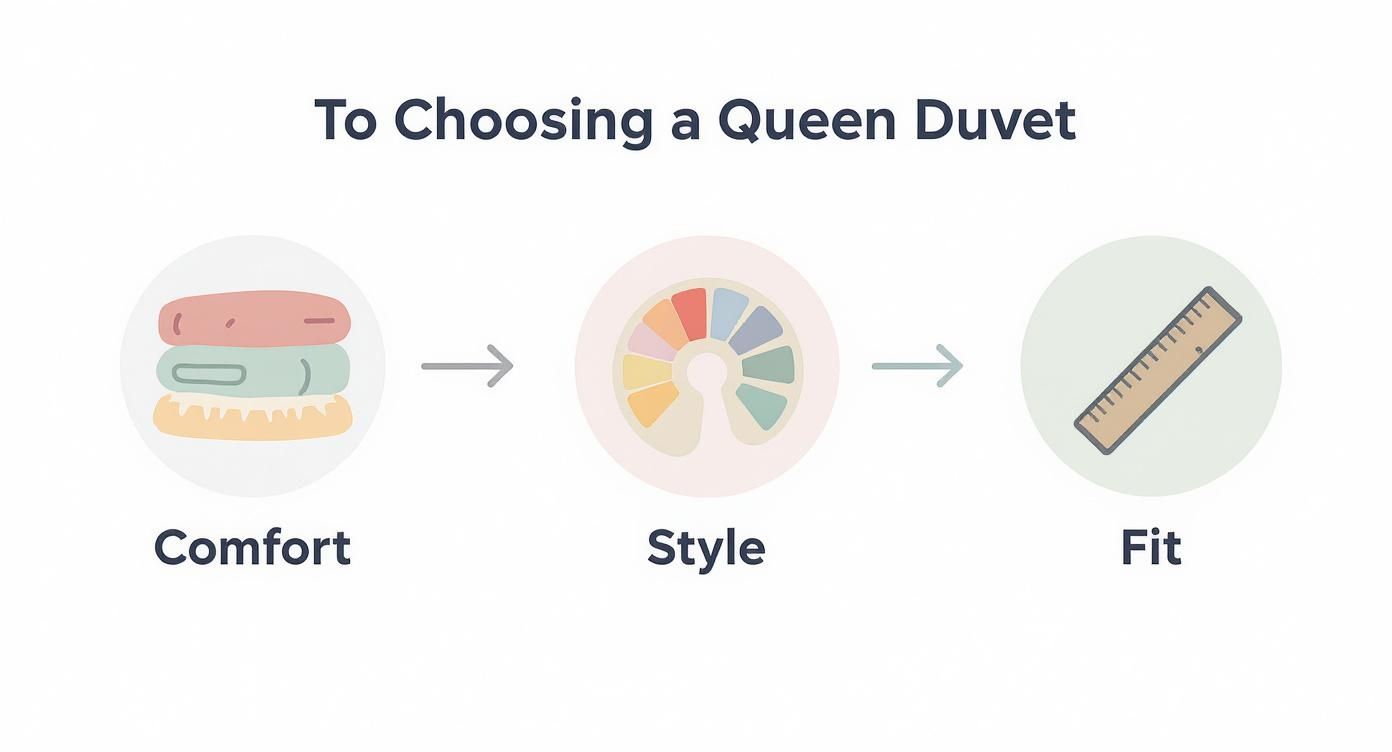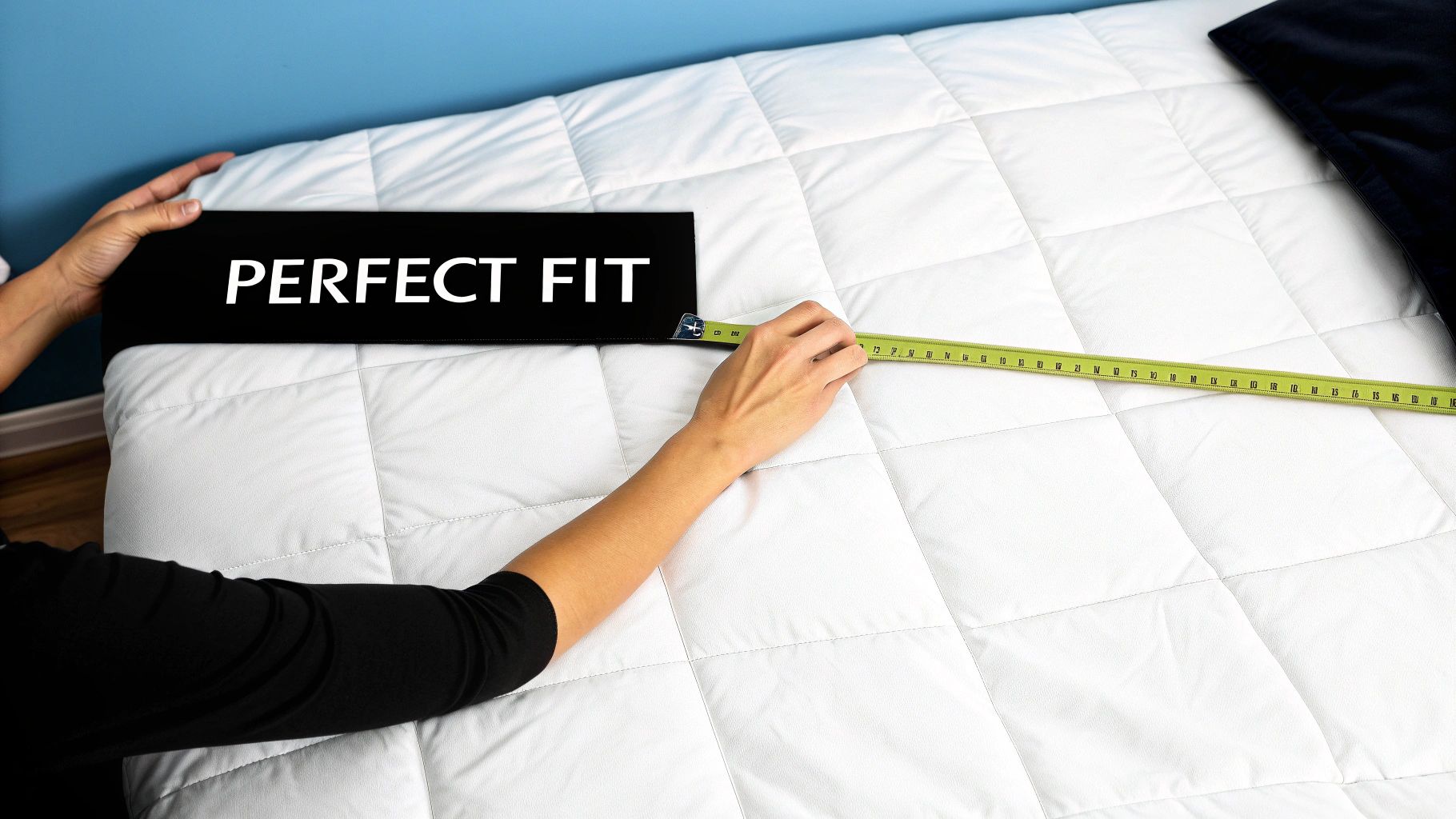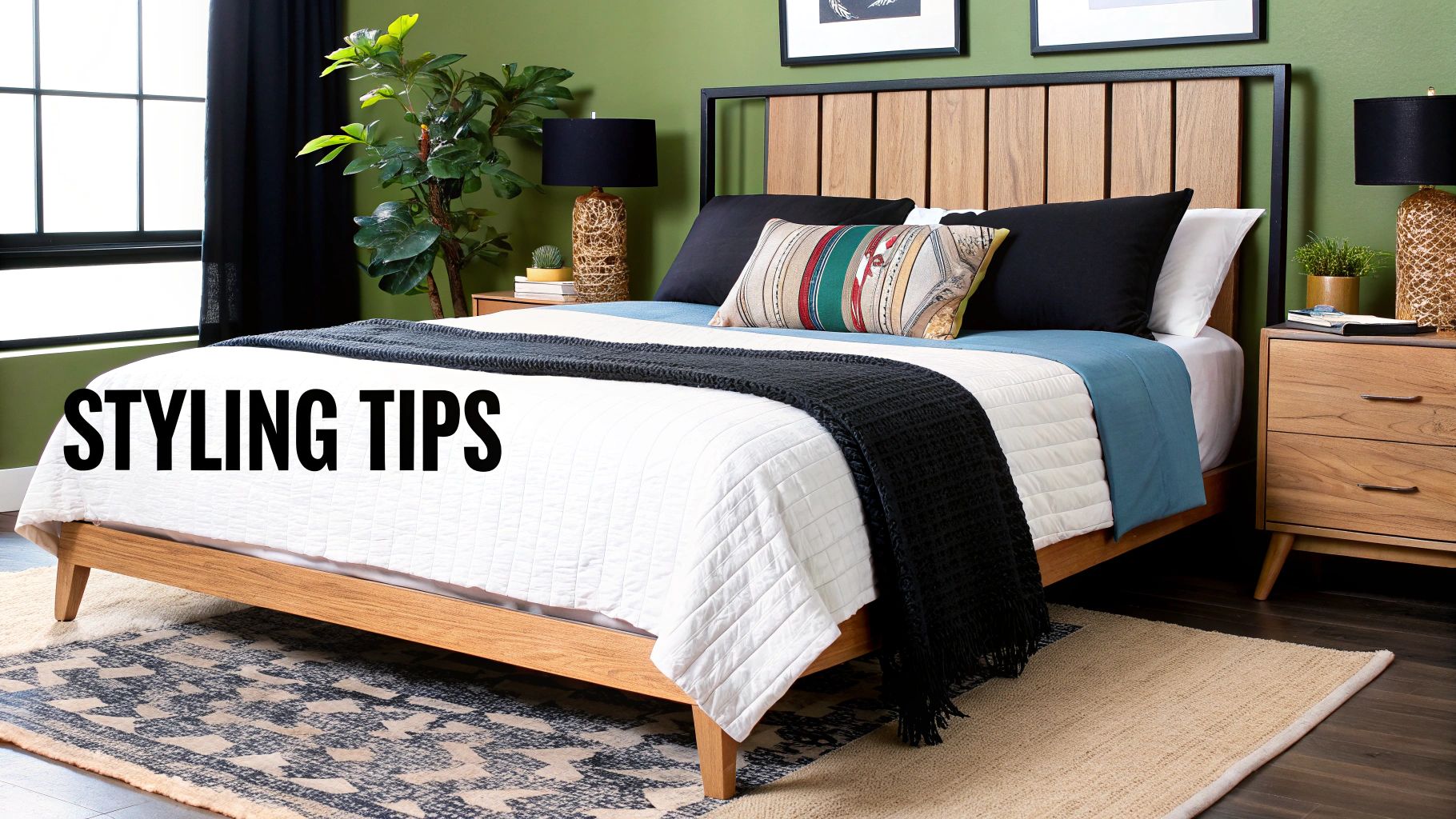Think of a queen size duvet cover as more than just a protective sleeve for your duvet. It’s the visual anchor of your bedroom, the one piece that can single-handedly define the entire space and set the tone for your personal sanctuary.
Why Your Duvet Cover Matters More Than You Think
Picking the right queen size duvet cover isn't just a minor shopping decision; it directly influences your bedroom's comfort, style, and overall vibe. As the largest piece of fabric in the room, its colour and texture command attention, making it the most powerful design element you can work with.
A great cover can turn an ordinary room into a luxurious retreat. The wrong one? It can throw off the whole balance you've tried so hard to achieve.
But it’s not all about looks. The fabric you choose is right up against your skin all night, so it has a huge say in your sleep quality. A light, airy linen cover is a lifesaver during a humid Auckland summer, while a snuggly brushed cotton is just what you need for a frosty Queenstown winter. This guide will walk you through everything, ensuring you find a cover you'll be happy with for a long time.
Key Factors in Your Decision
When you're on the hunt for the perfect queen duvet cover, a few key things need to line up. Thinking about them together is the best way to find that sweet spot between style and function.
- Material: The fabric dictates the feel, how well it breathes, and how long it will last.
- Size and Fit: A sloppy or overly tight fit looks messy and feels uncomfortable. Getting the size right is crucial.
- Style and Colour: The design needs to work with your existing decor to create the mood you're after.
- Care and Maintenance: Be realistic about how much time you want to spend on laundry. An easy-care cover can be a game-changer.
The queen bed is a staple in most New Zealand homes, and the market reflects that. The Kiwi bedding industry was valued at an impressive NZ$122.72 million in 2025, with no signs of slowing down. This popularity is great news for shoppers, as it means there’s a massive range of styles and materials to choose from.
A duvet cover is to your bed what a jacket is to an outfit—it provides protection, adds a layer of comfort, and makes a powerful style statement. It’s the easiest way to refresh your bedroom's entire look without a complete overhaul.
With these core ideas in mind, you can confidently sort through your options and land on a piece that not only looks fantastic but makes your bed the best place to be.
To help you weigh your options at a glance, here’s a quick reference table.
Queen Duvet Cover Quick Reference
| Attribute | Key Consideration | Best For |
|---|---|---|
| Material | Breathability, feel, and durability. | Cotton for versatility, linen for warm sleepers, microfibre for easy care. |
| Size & Fit | Match cover dimensions to your duvet insert. | A slightly larger cover for a lofty look; an exact match for a neat fit. |
| Style & Colour | Complements room decor and personal taste. | Neutral tones for calming spaces; bold patterns for a statement piece. |
| Care | Machine washability and wrinkle resistance. | Busy households or anyone who prefers a low-maintenance routine. |
Choosing the right cover is the perfect starting point. Of course, a truly polished look often comes from coordinating pieces like pillowcases and throws. If you’re ready to build out your entire bedding set, you can explore our full range of bedding options to find everything you need.
Understanding Duvet Cover Materials and Weaves
Choosing the right material for your queen size duvet cover is a bit like picking out a favourite outfit. It’s not just about how it looks, but how it feels. The right fabric can genuinely improve your sleep, working with your body and the room’s temperature to create the perfect comfort zone.
Think of it this way: some fabrics are like a crisp, cool shirt, perfect for a warm day. Others are like a soft, cosy jumper, ideal for curling up in on a cold night. Each material has its own personality and practical benefits, which is especially important given New Zealand's varied climate.
The Most Popular Fabric Choices
Let's break down the materials you'll most often come across. Getting to know their unique characters is the first step in finding your perfect match.
- Cotton: The undisputed classic, cotton is loved for its breathability and durability. But not all cotton is created equal. The "weave" is what creates different textures and feels.
- Linen: Known for its relaxed, slightly rumpled look, linen is incredibly strong and gets softer with every wash. It’s a fantastic choice for hot sleepers thanks to its exceptional breathability and moisture-wicking properties.
- Bamboo: A wonderfully soft and silky option, bamboo is naturally hypoallergenic and great at regulating temperature. It drapes beautifully and has a subtle sheen that adds a touch of elegance.
- Flannel: When winter hits, flannel is the go-to. It’s made from cotton that has been brushed to raise the fibres, creating a soft, fuzzy texture that traps body heat to keep you warm and snug.
This handy decision tree can help you visualise the path to choosing the perfect duvet cover, starting with the most important factor: comfort.

As you can see, picking the right fabric is the foundational step that influences everything else, from the style you choose to the overall fit on your bed.
Weave Wars: Percale vs Sateen
When you see "100% cotton," the story doesn't end there. The weave—how the threads are interlaced—is what really defines the final feel of the fabric. For a queen size duvet cover, the two most common weaves you'll encounter are percale and sateen.
Imagine a simple grid. Percale uses a straightforward one-thread-over, one-thread-under pattern. This creates a matte finish with a light, crisp feel, much like a freshly pressed shirt. It's highly breathable, making it a firm favourite for those who tend to sleep warm. It has that classic "cool side of the pillow" feeling all over.
Sateen, on the other hand, uses a more complex three-or-four-threads-over, one-thread-under pattern. This technique exposes more thread surface, resulting in a silkier, smoother feel with a noticeable lustre. Sateen is a little heavier and warmer than percale, offering a more luxurious and cosy sensation against the skin.
Your choice between percale and sateen is purely personal. Do you prefer the cool, crisp embrace of a classic hotel sheet (percale), or the buttery-soft, draping luxury of a silky fabric (sateen)?
Linen: The Effortlessly Chic Option
Linen deserves a special mention, particularly for how well it suits the New Zealand lifestyle. Derived from the flax plant, it’s one of the strongest natural fibres out there, meaning a high-quality linen duvet cover is a real investment.
Its unique structure allows for incredible airflow, making it self-cooling in summer and surprisingly insulating in winter. While some might be put off by its natural tendency to wrinkle, many find this is part of its charm, lending a relaxed and lived-in elegance to the bedroom. If you're considering this timeless material, you can explore the unique benefits of linen duvet covers in NZ.
Ultimately, the best material is the one that lines up with what you find comfortable. Whether you prioritise the airy coolness of linen, the crispness of percale, or the silky touch of sateen, understanding these differences empowers you to choose a duvet cover that will give you a perfect night's sleep for years to come.
Getting the Right Fit for Your Queen Duvet

You’ve found the perfect material and a design you love, but now for the technical bit: getting the dimensions of your queen size duvet cover spot on. This is where even the most luxurious bedding can go wrong. If the cover is too baggy, your duvet insert will swim around inside and bunch up. Too tight, and it’ll compress the filling, robbing it of that lovely, lofty fluffiness.
Here in New Zealand, the standard measurement for a queen duvet cover is 210cm x 210cm. This perfectly square shape is our local standard, made to fit a Kiwi queen duvet insert like a glove. But with so many of us shopping online from international brands, it's surprisingly easy to end up with a cover that just doesn't fit.
The biggest trip-up is assuming that "queen" means the same thing everywhere. It absolutely doesn't. A queen size duvet cover from the US or the UK will have completely different measurements, which can lead to a really frustratingly poor fit once you get it home.
It's All About the Drape
Getting the right size is about more than just fitting the insert; it's about achieving what designers call ‘drape’. This is simply the elegant way the duvet hangs over the sides and foot of your bed. It’s the secret sauce that gives a bed that plush, inviting, and professionally styled finish.
A cover that’s too small for the bed, even if it fits the duvet inside, can look skimpy and mean. The perfect drape allows the fabric to hang gracefully over the mattress edges, creating a feeling of abundant comfort and luxury. Nailing this small detail is a simple way to elevate your entire bedroom.
How to Measure for a Perfect Fit
Never, ever trust the "queen" label on the packaging alone. The only foolproof way to guarantee a perfect fit is to measure your actual duvet insert before you start shopping. It takes less than a minute and will save you a world of hassle.
Just follow these simple steps:
- Lay your duvet insert out flat on your bed.
- Smooth it down to get rid of any lumps or bunched-up areas.
- Using a tape measure, check the width from one side to the other.
- Then, measure the length from the top edge right down to the bottom.
Jot these numbers down. Your ideal duvet cover should be very close to these measurements, or perhaps 2-3cm larger to give it a little breathing room. This ensures the insert fits snugly without being squashed.
A classic mistake is buying a cover based on your mattress size. Always remember: the duvet cover is for the duvet insert, not the mattress. The loft and dimensions of your insert are what really count.
Navigating International Sizing
Shopping online is fantastic for variety, but it throws the curveball of different international standards into the mix. A quick comparison shows just how much "queen" sizes can vary from country to country. For a deep dive, our guide to duvet cover sizes in NZ has even more detail.
But to help you shop confidently, here’s a quick look at how things stack up overseas.
International Queen Size Duvet Cover Dimensions
This table highlights just how different a "queen" can be depending on where you're buying from.
| Region | Typical Dimensions (cm) | Key Difference |
|---|---|---|
| New Zealand | 210cm x 210cm | Our local square standard. |
| Australia | 210cm x 210cm | Generally the same as New Zealand. |
| United Kingdom (King) | 225cm x 220cm | Noticeably wider and longer. Note: their 'King' is the closest equivalent to our Queen. |
| United States (Queen) | 229cm x 224cm | Significantly wider and longer to fit larger US mattresses. |
As you can see, buying a US "Queen" cover for your NZ queen insert would leave you with almost 20cm of extra fabric in the width. That’s a recipe for a sloppy, unkempt bed.
The bottom line? Always ignore the name and check the specific centimetre dimensions in the product description. Do that, and you'll guarantee a flawless, beautiful fit every single time.
Styling Your Bedroom Like a Pro

Think of your queen size duvet cover as the lead actor on your bedroom's stage. It’s the single biggest piece of fabric in the room, so it naturally draws the eye and sets the mood for the entire space. Getting the style right can elevate your room from just a place to sleep into a personal sanctuary that feels uniquely you.
Whether you’re dreaming of a calm, minimalist retreat or a vibrant, bohemian escape, the duvet cover is your starting point. The colour, pattern, and texture you choose will be the foundation for every other design decision you make.
Finding Your Core Colour Palette
First things first, let's talk colour. The shade you choose for your duvet cover will anchor your entire room's palette, so it's a decision that really matters.
Light, airy colours like crisp white, soft grey, or a warm oat can make a room feel bigger and more serene. They have that clean, boutique hotel vibe that’s both calming and timeless. A classic white queen size duvet cover, for instance, is the perfect blank canvas—you can pair it with literally any accent colour you can imagine.
If you’d rather create a cosy, cocooning effect, go for deeper, moodier tones. A rich charcoal, forest green, or deep navy absorbs light, making a space feel more intimate and sophisticated. It’s perfect for turning your bedroom into a restful hideaway.
A great interior design trick is the 60-30-10 rule. Aim for 60% of your room to be a primary colour (like your walls), 30% a secondary colour (your duvet cover is perfect for this), and the final 10% for small accents (think cushions or art).
The Power of Pattern and Texture
Once you’ve settled on a colour family, you can start playing with patterns and textures to add personality and depth. A bold pattern can make a huge statement, but the secret is to strike the right balance.
If you fall head over heels for a striking floral or a bold geometric print for your duvet cover, let it be the star of the show. Keep the surrounding elements, like your sheets and curtains, in simple, solid colours. This allows the pattern to shine without overwhelming the room.
Texture is a more subtle but equally effective tool for adding character. Even a plain-coloured duvet cover can bring a ton of visual interest if it has a great feel.
- Waffled Cotton: Gives off a relaxed, spa-like feel.
- Crinkled Linen: Looks effortlessly chic and laid-back.
- Velvet or Flannel: Adds a touch of luxury and comforting warmth.
The real secret to a professionally styled bed is mixing these textures. Imagine a smooth cotton sateen duvet cover topped with a chunky knit throw and a couple of velvet cushions. That combination creates a rich, layered look that feels both carefully designed and incredibly inviting.
Layering for a Designer Finish
Layering is what separates a bed that’s simply "made" from one that’s "styled." It’s all about building up different elements to create that plush, comfortable look you see in magazines.
Start with your base layers: a fitted sheet and a top sheet. Then, add your queen size duvet cover. Now, the fun part begins.
- Pillows: A beautifully styled bed always has more than just two sleeping pillows. Start with your usual two pairs, then prop two large, square Euro pillows against the headboard. To finish, toss one to three smaller decorative cushions in front, mixing up the shapes, colours, and textures.
- Throws and Blankets: A neatly folded blanket or a throw casually draped across the foot of the bed is the perfect finishing touch. It adds another layer of texture and can introduce a final pop of your accent colour.
Don't be afraid to mix and match to find what you love. The goal is to create a bed that looks like a luxurious escape, beckoning you to dive in at the end of a long day. Once your bedroom is looking perfect, you might find inspiration for the rest of your home with these creative home renovations to transform your space.
How to Care for Your Duvet Cover
A beautiful queen size duvet cover is a real investment, both in your comfort and your bedroom's style. To keep it looking and feeling fantastic for years, a little mindful care goes a long way. It's not just about preserving the fabric; it's about making sure your bed remains that soft, inviting centrepiece of your sanctuary.
The good news? Looking after luxury bedding isn't complicated. It just requires a slightly different approach depending on what it's made of. You wouldn't wash a delicate silk shirt the same way you wash a pair of hardy jeans, and the same logic applies here. Each fabric has its own quirks and needs to truly thrive.
Material-Specific Washing Instructions
The first step to washing your duvet cover correctly is knowing its fabric. Different materials react differently to water temperature, heat, and detergents, so tailoring your laundry routine is the secret to its longevity.
- Cotton (Percale & Sateen): These are workhorse fabrics and generally easy to care for. Pop them in a warm wash with a mild, liquid detergent. A pro-tip is to skip the fabric softener—it can leave a residue on the fibres that reduces their natural breathability over time.
- Linen: Linen is a fascinating material that actually gets softer and more absorbent with every wash. Use a gentle cycle with lukewarm water and a mild detergent. For a deeper dive, our guide on washing and caring for luxury European linen has all the expert advice you'll need.
- Bamboo: Known for its silky softness, bamboo bedding needs a delicate touch. Always wash it in cold water on a gentle cycle. High heat is the enemy here, as it can cause those delicate fibres to pill or even shrink.
No matter the material, always remember to close any buttons or zips before you pop it in the wash. This one simple step prevents snagging and helps your duvet cover keep its shape beautifully.
Drying, Stain Removal, and Storage
How you dry, treat, and store your queen size duvet cover is just as crucial as how you wash it. These final steps are what keep the colour vibrant, the texture soft, and everything feeling fresh between uses.
When it comes to drying, nothing beats line drying—especially here in New Zealand. The sun is a natural disinfectant and bleaching agent, which is brilliant for keeping your whites bright and crisp. If you have to use a machine, tumble dry on a low heat setting. Try to pull the cover out while it's still slightly damp; it's the best way to minimise wrinkles.
For those inevitable spills and stains, act fast. Gently blot the area with a clean, damp cloth—never rub, as that can push the stain deeper. For oily marks, a sprinkle of baking soda can work wonders to absorb the grease before you wash the cover as usual.
Proper storage is the final piece of the puzzle. To avoid that musty smell and deep-set creases, make sure your duvet cover is 100% dry before folding it away. Store it in a cool, dry, and well-ventilated linen closet. It's best to avoid sealing it in plastic bags, as they can trap moisture and lead to mildew.
By following these straightforward steps, you're not just cleaning your bedding—you're protecting your investment and ensuring that climbing into bed feels like a luxurious treat, every single night.
Finding Your Perfect Luxury Duvet Cover
https://www.youtube.com/embed/HtbXpGm_hZM
When you're ready to treat yourself to a truly exceptional night's sleep, a luxury queen size duvet cover is one of the best investments you can make. But what does "luxury" really mean? It’s not just a steeper price tag; it's the sum of incredible materials, careful craftsmanship, and all the little design details that create something special.
Learning to spot these markers of quality is what separates a good purchase from a great one. It means looking past the pretty packaging to understand what you're actually buying. From where the cotton was grown to how the seams are finished, every detail contributes to how the bedding feels and how long it will last.
The Real Story Behind Thread Count
For years, we've been told that a higher thread count equals better quality. But the truth is a bit more complicated. Thread count is simply the number of threads woven into one square inch of fabric. While a higher number can mean a denser weave, it's definitely not the only thing that matters.
In fact, the quality of the fibres is far more important than the quantity. A 300-400 thread count duvet cover made from top-tier, long-staple cotton (like Supima® or Egyptian) will feel worlds better and last much longer than a 1000-thread-count cover made from cheap, short fibres. Those ultra-high counts are often achieved by twisting together weaker, thinner threads, which creates a heavy, less breathable fabric that's likely to pill.
Focus on a moderate thread count (around 400 is often the sweet spot) combined with premium fibres. This is the true formula for bedding that is both exquisitely soft and wonderfully breathable.
Why Fibre Origin and Weave Matter
Where the raw material comes from makes a huge difference. When you see a label like Egyptian cotton, it refers to a specific type of cotton grown in the Nile River Valley, famous for its extra-long staples. These long, silky fibres can be spun into incredibly fine, strong yarns, which results in fabric that's smooth, durable, and naturally resists pilling.
Just as important is the weave, which determines the final feel of the fabric. For a luxury queen size duvet cover, you'll generally be choosing between two main styles:
- Percale: This is a simple, tight weave that gives the fabric a crisp, cool feel and a matte finish. If you love the feeling of slipping into a freshly made bed at a five-star hotel, you'll love percale. It's light and breathable.
- Sateen: This weave has a different structure that exposes more of the thread's surface, creating a buttery-soft feel, a subtle sheen, and a heavier drape. It feels incredibly smooth against the skin and offers a richer, cosier experience.
Which one is right for you is all down to personal preference. Are you after the refreshing crispness of percale or the sumptuous softness of sateen?
Spotting Superior Craftsmanship
The final clue to a luxury duvet cover is in its construction. The finishing touches are what really show a commitment to quality, ensuring your bedding not only looks beautiful but is practical and built to last. When you're looking at a high-end duvet cover, keep an eye out for these tell-tale signs of great craftsmanship.
Key Finishing Details to Look For:
- Secure Internal Ties: These are non-negotiable. Small fabric ties sewn into the four inside corners of the cover are essential for holding your duvet insert in place, preventing it from bunching up into a lump overnight.
- Elegant Closures: Look for well-made button closures, often crafted from natural materials like mother-of-pearl. Hidden or "invisible" zips are another sign of a thoughtful design, giving the foot of your bed a clean, seamless finish.
- Tailored Edges: Details like a flange (a decorative fabric border) or neat hemstitching add a touch of polish and elegance. These finishes take more skill to produce, so they're a clear indicator of a high-quality piece.
By paying attention to these three things—fibre quality over inflated thread counts, the feel of the weave, and those small but crucial finishing details—you can confidently choose a luxury queen size duvet cover. It’s an investment in genuine quality that will bring you comfort for years to come.
Common Questions About Queen Duvet Covers
Even after weighing up all the materials and styling options, you might still have a few lingering questions. That's perfectly normal. Getting those final details sorted is what gives you the confidence to know you're making the right choice.
We hear these questions all the time, so let's tackle them head-on with some quick, practical answers to help you finalise your decision.
What Is the Standard Queen Size in NZ?
In New Zealand, the standard size for a queen duvet cover is 210cm x 210cm. This square shape is designed to perfectly fit our local queen duvet inners.
It's always a good idea to quickly check the label before you buy, though. While most local brands stick to this measurement, you can occasionally find slight variations. Be extra careful if you're shopping from international stores, as their 'queen' size can be quite different from ours.
How Often Should I Wash My Duvet Cover?
A good rule of thumb is to wash your duvet cover every one to two weeks, right along with your sheets and pillowcases.
If you have pets who love a good cuddle in bed, suffer from allergies, or are a naturally warm sleeper, you'll probably want to stick to a weekly wash. This simple habit keeps dust, oils, and allergens at bay, creating a much healthier and more inviting bed. Just remember to follow the care instructions on the tag to keep the fabric looking and feeling its best.
Thread count is a factor, but it isn't the whole story. The quality of the fibre is far more important. A 300-thread-count cover made from high-quality, long-staple cotton will feel much better and last longer than a 1000-thread-count cover made from inferior, short-staple fibres.
Instead of getting fixated on numbers, pay more attention to the type of material and the weave, like a crisp percale or a silky-smooth sateen. That's a far better indicator of how your bedding will actually feel and wear over time.
At The Foxes Den, we believe true luxury lies in exceptional materials and enduring design. Explore our curated collection of premium linen and Supima® cotton bedding to find the perfect piece to elevate your home. Discover the collection.


